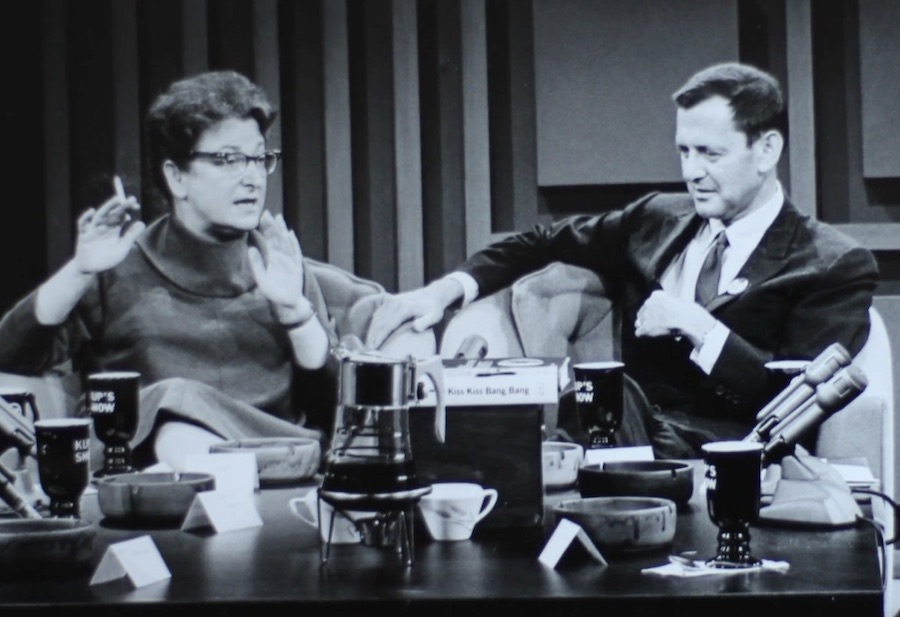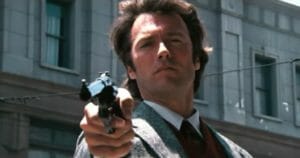Pauline Kael Gets the Last Word in ‘What She Said’
Documentary director Rob Garver explores the prose, controversies and lasting legacy of perhaps the most enduring of America’s film critics, whose work didn't always garner favorable reviews from her peers. Film critic Pauline Kael holds forth in this still image from Rob Garver's documentary, "What She Said." At right, actor Tony Randall. (Rob Garver / YouTube)
Film critic Pauline Kael holds forth in this still image from Rob Garver's documentary, "What She Said." At right, actor Tony Randall. (Rob Garver / YouTube)
If “What She Said: The Art of Pauline Kael” had been made about any other film critic, I believe Kael would have enjoyed it. But it couldn’t have been made about any other critic.
The documentary directed by Rob Garver, which premiered Sunday, Nov. 11, at DOC NYC, hums along at a steady, pleasurable pace, combining snippets of interviews with Kael (the best ones with Dick Cavett on his television show) juxtaposed with snatches from films. The latter includes movies she praised and for which she helped create an audience (“Bonnie and Clyde,” “Mean Streets,” “Carrie,” “Nashville,” “McCabe and Mrs. Miller,” “The Wild Bunch,” “The Godfather,” “The Godfather Part II,” “The Elephant Man,” “Band of Outsiders”) as well as those she panned, angering mainstream America (“The Sound of Music,” “West Side Story”) and offending college-educated filmgoers (“Blow-Up,” “2001: A Space Odyssey”).
Sarah Jessica Parker reads some of Kael’s prose and does an admirable job of replicating her idiosyncratic rhythms. Voices of contemporary critics attest to the enormous impact and influence of Kael, who wrote for The New Yorker magazine from 1967 to 1991 and died in 2001. Filmmakers—including Paul Schrader, Francis Ford Coppola, David O. Russell and Quentin Tarantino—talk about how her work shaped their own attitudes about film and its possibilities. Kael’s daughter, Gina James, brings a little salt to her recollections—it apparently wasn’t easy to be a child of a genius—and the late Brian Kellow, author of “Pauline Kael: A Life in the Dark” (2011), adds nuance and perspective.
Garver, a New York-based writer and director of film shorts, loves his subject but knows when to keep his distance. His handling of the most famous controversies of Kael’s career is concise and even-handed.
One example of this is Kael’s famous essay in which she mercilessly diced Andrew Sarris’ interpretation of the auteur theory, particularly the part about the director’s personality being a criterion for greatness. Sarris’ widow, the film critic Molly Haskell, says Kael’s piece was “almost slanderous.” (For the historical record, I’d like to note that there was no feud between Kael and Sarris, that her notes on the auteur theory were the only negative things she ever wrote about his work, and in Francis Davis’ “Afterglow,” Kael is quoted as saying, “We both loved movies. We had that in common, and I enjoy reading him as I enjoy reading very few critics. He has genuine reactions to movies, and many critics don’t. He picks things up and points things out.”
And then there was the famous blast by Renata Adler in the New York Review of Books in 1976, reviewing Kael’s collection, “When the Lights Go Down”: “Jarringly, piece by piece, line by line, and without interruption, [it’s] worthless.” And this just two years after Kael won the National Book Award for her previous “Deeper Into Movies.”
Even worse, Adler saw Kael as symptomatic of something gone wrong in American life. It’s always fascinated me that Adler also once wrote, famously, “No essay becomes as quickly obsolete as an unfavorable review.”
In retrospect, “When the Lights Go Down” might have been Kael’s best collection and contains many pieces that have been anthologized over the decades, including “The Man From Dream City (Cary Grant),” “Fear of Movies” and “Notes on the Nihilist Poetry of Sam Peckinpah,” as well as the famous reviews of “Taxi Driver,” “The Deer Hunter,” “Invasion of the Body Snatchers” and “Julia” (in which she anticipated Mary McCarthy’s later exposé of Lillian Hellman). What an irony if those negative lines Adler wrote about Kael prove to be the most enduring words she ever wrote.
In a snide piece for the now-defunct LOLA in 2011, a writer named Richard Porton said Kael “was, when all is said and done, just another working critic. And in a desperate attempt to be hip during her tenure at the New Yorker, she now seems much more dated than [Andre] Bazin, [Manny] Farber or [James] Agee.” Well, I don’t know what film critics Porton is still reading, and I know people who still read Bazin, Farber and Agee, but more than 17 years after her death, I’m pretty sure that Kael is still read by more people than the three of them put together, and certainly more than any or maybe all the critics on Rotten Tomatoes.
And she’s certainly the only critic who still inspires biographies and documentaries.
As Gary Indiana wrote in a 2002 edition of Artforum magazine, “It is … the absence of any real sensibility rooted in any consistent method of analysis that makes Pauline Kael’s collections of reviews the kind of books I don’t like having in my house.”
I take it that “consistent method of analysis” is a fancy phrase for theory. But Indiana, like others who criticized Kael’s resistance to “theory,” never gets around to telling us what theories work for him, and the names of the authors of said books he has in his house.
As if in answer to Indiana, “What She Said” director Garver shows Kael saying in an old TV interview, “Only bad critics impose an academic formula. One does not need to rationalize one’s instincts. One’s instincts are the sum total of one’s mind and responses.”
It was precisely Kael’s antipathy to film theory and dogma of any kind that exasperated so many at the Village Voice in the 1980s. As Kellow wrote in his biography, by 1985—when the firestorm over Kael’s criticism of “Shoah” was at high heat—the Voice had become “her by now regular adversary.” I was there during those years, and scarcely a week went by when I didn’t pick up on some hostile remark about Kael or something she had written, often from arts editor Karen Durbin. David Edelstein told Kellow, “The reason the Voice hated her was that she wasn’t politically correct. It was as simple as that. … They were cultural commissars there.”
Kael’s dislike of the nine-hour film—“I found ‘Shoah’ logy and exhausting right from the start, and when it had been going on for an hour or longer, I was squirming restlessly, my attention slackening”—enraged the Voice’s J. Hoberman, who told an interviewer, “She didn’t see ‘Shoah’s’ worth because the movie refrained the violence to which she was so obviously addicted”—an odd complaint coming from a critic who was a stout defender of Clint Eastwood’s vigilante cop movies.
Kael was the most influential American critic since … well, I can’t think of a critic that influential before Kael. H.L. Mencken, maybe, but as someone said in a Hemingway novel, no one reads Mencken anymore (and that was in the 1920s). Edmund Wilson may well be the most admired of all American literary critics, but could he really be said to have been an influence on writers who followed him? Even if you could make that case, would it be argued that Wilson had a widely popular influence?
Writers who at one time or another gathered around Kael, joining her for dinner or drinks or just screenings, have been referred to under the pejorative title “Paulettes.”
It’s time to dispel the notion that somehow Kael’s influence on other writers was somehow bad. She once asked me, “Haven’t some of the writers I’ve tried to help turned out pretty good?” They sure did. The film critics most often associated with Kael—David Edelstein (New York Magazine/Vulture), Stephanie Zacharek (Time magazine), Michael Sragow (Film Comments, among others), Joe Morgenstern (The Wall Street Journal), Peter Rainier (Christian Science Monitor), Hal Hinson (The Washington Post), Carrie Rickey (Truthdig) and others, including David Denby, Charlie Taylor and Terrence Rafferty—would surely acknowledge her influence on their work. So too would playwright John Guare, literary critic Craig Seligman, author of “Sontag and Kael: Opposites Attract Me,” theater critic Steve Vineberg, jazz critic Francis Davis (author of “Afterglow: A Last Conversation With Pauline Kael”), and Vanity Fair’s pop culture critic James Wolcott (who created a vivid and affectionate portrait of Kael in his memoir “Looking Out”), and cultural critic (and I hate that phrase) Greil Marcus.
Would anyone looking at that list of names think that they could be lumped together under the label “Paulettes”? I don’t think Wolcott and Marcus could sit at the same table and pass the salt without dropping it.
Let’s call one more witness. I don’t think anyone would dare call Camille Paglia a Paulette. To my knowledge, she never even met Kael, but she provides some of the liveliest moments in Garver’s film, talking about how much she enjoyed reading Kael “even while she was attacking the movies I loved.” The Italian Stallioness of American letters gleefully quotes the title of a chapter in Kael’s first book, “I Lost It at the Movies”: “The Come-Dressed-as-the-Sick-Soul-of-Europe Parties: ‘La Notte,’ ‘Last Year at Marienbad,’ ‘‘La Dolce Vita.’ ”
Paglia went into greater detail in Salon in her 2011 review of Kael’s collection, “The Age of Movies.” What especially impressed her was “Kael’s emphatic use of the colloquial American voice. … I despise the same fancy-pants rhetoric of professors aping jargon-filled European locutions which have blighted academic film criticism for over thirty years. … Her voice, shaped by the American idiom, is still utterly fresh and dynamic. She is a superb role model for young writers.”
To paraphrase something Kael once said about Hemingway, she took the stuffiness out of fine writing. Here are some of my favorite Kaelisms:
—On “Love Story”: Erich Segal has “written the generation gap ‘Madam X’—this kind of schlock can only be written by the true schlock artists who can feel it all as true.”
—“West Side Story”: “Consider the feat: First you take Shakespeare’s ‘Romeo and Juliet’ and remove all that cumbersome poetry. Then you make the Montagues and Capulets really important and modern by turning them into rival street gangs of native-born and Puerto Ricans. (You get rid of the parents, of course, America is a young country—and who wants to be bothered by the squabbles of older people?). … The only difference between these two gangs of what I’m tempted to call ballerinas is that one group has faces and hair darkened, and the other group has gone wild by glittering yellow hair dye. … They’re about as human as the Munchkins in ‘The Wizard of Oz.’ ”
—On Kubrick’s “2001: A Space Odyssey”: “It has the dreamy somewhere-over-the-rainbow appeal of the new vision of heaven. ‘2001’ is a celebration of cop-out. … There’s an intelligence out there in space controlling your destiny from ape to angel, so just follow the slab. Drop up … [The audience] can go to heaven in Cinerama.”
—On Woody Allen’s “Interiors”: “The people in … ‘Interiors’ are destroyed by the repressiveness of good taste, and so is the picture. ‘Interiors’ has the beautiful, solemn, visual clarity of a Bergman film, without, however, the eroticism of Bergman. ‘Interiors’ looks so much like a masterpiece and has such a super-banal metaphysical theme (death vs. life) that it’s easy to see why many regard it as a masterpiece: It’s deep on the surface. … ‘Interiors’ is a handbook of art film mannerisms.”
—Norman Mailer’s book, “Marilyn”: “Who knows what to think about Marilyn Monroe or about those who turned her sickness to metaphor. I wish they’d let her die.”
—Martin Scorsese’s “Mean Streets”: “The picture is stylized without seeming in any way artificial. It is the only movie I’ve ever seen that achieves the effects of Expressionism without the use of distortion.”
—And on what she regarded as Scorsese’s excess in “Raging Bull”: “The tragedy in Scorsese’s struggles with the material … is that he’s a great director when he doesn’t press so hard at it, when he doesn’t suffer so much. He’s got moviemaking and the church mixed up together. He’s trying to be the saint of cinema.”
—On the Taviani brothers’ “Night of the Shooting Stars”: “It’s so good it’s thrilling. … [It] encompasses a vision of the world. Comedy, tragedy, vaudeville, melodrama—they’re all here, and inseparable.”
—On Burt Lancaster in “Atlantic City”: “He uses his big, strong body so expressively that if this were a stage performance the audience would probably give him a standing ovation.”
—Satyajit Ray: “No artist has done more to make us evaluate the common place.”
—On Marlon Brando in “The Godfather”: “He has not acquired the polish of most famous screen actors, just the opposite—less mannered as he grows older. … He gives the story a legendary presence needed to raise it above gang warfare to archetypal tribal warfare.”
—“The Godfather Part II”: “The violence in this film never doesn’t bother us—it’s never just a kick. … Coppola controls our emotional responses so that the horror seeps through everything and no action provides a melodramatic release.”
—Faye Dunaway in “The Eyes of Laura Mars”: “She’s gloriously beat out, no Hollywood sex goddess ever presented so alluring an image of kinky Death herself.”
—Richard Pryor in “Live on the Sunset Strip”: “… a master of lyrical obscenity.”
—On Marguerite Duras’ “The Truck”: “There are some people who are too French for their own good. …”
—David Lynch’s “Blue Velvet”: “Its vision isn’t alienating: This is American darkness—darkness in color, darkness with a happy ending. Lynch might turn out to be the first popular surrealist—a Frank Capra of dream logic.”
It’s the tragedy for American film criticism that Pauline Kael did not live long enough to write about “Mulholland Drive.”
In his “Poetry Notebook,” Clive James maintains that “[i]ntensity of language” marks the real difference between poetry and prose and that “Concentrated meaning should be what any poet was after.” It’s probably high-falutin’ to press an argument that Kael’s style was poetic, but I think one must concede that her prose shared some characteristics with poetry.
In the interests of full disclosure, I was interviewed for “What She Said” but didn’t make the final cut. So don’t go expecting to see me. However, the child interviewer asking Kael questions at the beginning and end of the film is my daughter, Maggie, who was 10 at the time. She was working on a fourth-grade assignment, and her Q&A was the last interview before Kael died. It was reprinted at Salon after my review of Davis’ “Afterglow.”
Finally, here’s an animated “debate” between Andrew Sarris and Kael on the auteur theory, with dialogue paraphrased from their writings and interviews:
Your support matters…
Independent journalism is under threat and overshadowed by heavily funded mainstream media.
You can help level the playing field. Become a member.
Your tax-deductible contribution keeps us digging beneath the headlines to give you thought-provoking, investigative reporting and analysis that unearths what's really happening- without compromise.
Give today to support our courageous, independent journalists.







You need to be a supporter to comment.
There are currently no responses to this article.
Be the first to respond.